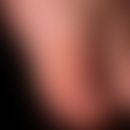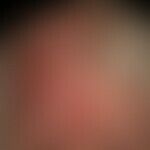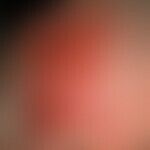Synonym(s)
HistoryThis section has been translated automatically.
DefinitionThis section has been translated automatically.
Rare variant of the scarring pemphigoid with solitary infestation of head, forehead and neck. No infestation of mucous membranes.
You might also be interested in
Occurrence/EpidemiologyThis section has been translated automatically.
Prevalence (Central Europe): 1.0 per 1 million inhabitants.
EtiopathogenesisThis section has been translated automatically.
The formation of IgG autoantibodies against the "bullous pemphigoid antigen 2" (BP180; bullous pemphigoid 180 kDa protein) and more rarely also against laminin 5 is discussed. The formation of the antigen-antibody complexes leads to complement-mediated chemotactic attraction of inflammatory cells or to the release of proteases that destroy hemidesmosomal structures.
A genetic predisposition to the disease is associated with the HLA-DQB1*0301 haplotype in Caucasians.
ManifestationThis section has been translated automatically.
Occurs in men of advanced age. Less common in women.
Clinical featuresThis section has been translated automatically.
The clinical picture is often misinterpreted as pyoderma or as zoster as in the patient shown in the picture; it superficially impresses as a chronic and therapy-resistant scarring alopecia with extensive erosions and crusts. Bubbles are only rarely registered and then only in an acute phase of relapse. Infection of the mucous membranes is absent in this variant of the scarring pemphigoid. S.a. scarring pemphigoid.
DiagnosisThis section has been translated automatically.
Clinic, histology, immunofluorescence. Recently, antibodies against LAD-1 were detected.
TherapyThis section has been translated automatically.
Corresponding to the scarring pemphigoid.
- The successful therapeutic approaches with dupilumab are to be regarded as (still) experimental (Raef HS et al. 2021).
Case report(s)This section has been translated automatically.
A 72-year-old man presented with scarring alopecia on the vertex of the scalp, multiple crusted plaques at the hairline, and a history of vesicular rash on the face. The scalp had crusted plaques with loss of follicular structures. An initial orienting scalp biopsy showed perifollicular neutrophils, lymphocytes, and plasma cells along with dermal fibrosis. Focal epidermal/dermal and follicular/adventitial skin clefts were seen, but were considered to be due to fibrosis, and the biopsy result was interpreted as neutrophil-mediated scarring alopecia.
Direct immunofluorescence (DIF) analysis revealed linear deposits of IgG and C3.
A repeat targeted scalp biopsy from a previously untreated skin area revealed more pronounced epidermal/dermal clefts, fibrosis, a mixed infiltrate with neutrophils, lymphocytes, histiocytes, and plasma cells, and pronounced follicular/adventitial dermal clefts with perifollicular neutrophils.
In conclusion, it has been shown that a neutrophil-rich form of cicatricial pemphigoid can be masked as neutrophil-mediated cicatricial alopecia.
LiteratureThis section has been translated automatically.
- Brunsting LA, Perry HO (1957) Benign pemphigoid? A report of 7 cases with chronic scarring herpetiform plaques about the head and neck. Arch dermatol 75: 489-501
- Duong DJ et al (2002) Thalidomide therapy for cicatricial pemphigoid. J Am Acad Dermatol 47(2 Suppl): S193-195
- Fleming TE et al (2000) Cicatricial pemphigoid. J Am Acad Dermatol 43: 571-591.
- García-Martín P et al (2014) Brunsting-Perry-type cicatricial pemphigoid with IgG autoantibodies to LAD-1. Br J Dermatol 170:743-745.
- Kreyden OP et al (2001) Successful therapy with tetracycline and nicotinamide in cicatricial pemphigoid. Dermatologist 52: 247-250
- Lee JB, Liu Y et al (2003) Cicatricial pemphigoid sera specifically react with the most C-terminal portion of BP180. J Dermatol Sci 32: 59-64
- Martín JM et al (2009) Cicatricial pemphigoid of the Brunsting-Perry type. Int J Dermatol 48: 293-294.
- Poon E et al (1999) Non-specific scalp crusting as a presenting feature of Brunsting-Perry cicatricial pemphigoid. J Eur Acad Dermatol Venereol 12: 177-178.
Raef HS et al (2021) Successful Treatment of Brunsting-Perry Cicatricial Pemphigoid With Dupilumab. J Drugs Dermatol 20:1113-1115.
Rahbar Z et al (2022) Cicatricial pemphigoid Brunsting-Perry variant masquerading as neutrophil-mediated cicatricial alopecia. J Cutan Pathol 49:408-411
Rice Gavazzoni Dias MF et al (2018) Brunsting-Perry Type Pemphigoid Causing Secondary Cicatricial Alopecia in 2 Patients. Skin Appendage Disord 4:308-311.
- Sugita Y et al (2001) Autoimmune vesicles on the face and neck. A variant of Brunsting-Perry type localized bullous pemphigoid? Eur J Dermatol 11: 557-559
- Vodegel RM et al (2003) Anti-epiligrin cicatricial pemphigoid and epidermolysis bullosa acquisita: differentiation by use of indirect immunofluorescence microscopy. J Am Acad Dermatol 48: 542-547.
Incoming links (1)
Mucous membrane pemphigoid;Outgoing links (5)
Alopecia scarring; Autoantibodies; Dupilumab; Laminin; Mucous membrane pemphigoid;Disclaimer
Please ask your physician for a reliable diagnosis. This website is only meant as a reference.










